Positive Health Online
Your Country

Migraine Links
by Vivienne Bradshaw-Black(more info)
listed in headaches, originally published in issue 213 - April 2014
The root meaning of migraine is ‘hemi-crania’.
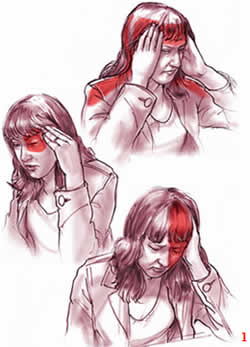
Virtually everyone is familiar with ‘migraine’ either in themselves,
family members or close friends and associates.[1]
Migraine is a painfully intense, pulsating severe headache, usually affecting one side of the head (hemi crania) and often accompanied by nausea, vomiting, visual and digestive disturbances, fluid retention, fatigue, back ache and especially a stiff neck. It is mostly considered an extremely painful inconvenience, causing lost work days and diminished quality of life rather than a medical problem.
Causes of migraine are widely acknowledged as ‘unknown’ but it is a well-documented incapacity about which there is abundant information explaining the types,[2] triggers, risk factors, common symptoms, treatments and some preventative measures which, unfortunately, seem to be limited in their effectiveness.
It is commonly thought by the medical profession that blood flow changes in the brain are a response to stresses which constrict arterial blood supply whilst increased platelet activity leads on to chemically induced distortions and further vascular constriction. Arterial response to a decrease in blood and oxygen supply is dilation; this is said to be the cause of the pain. The characteristic pain of migraine is not the same as skeletal muscle pain and this would fit in with the pain being from a vascular muscle source.
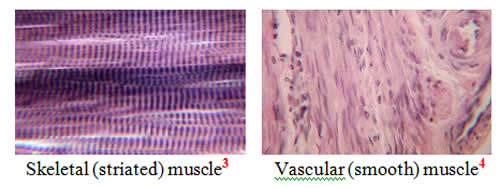
Stress to a cell, tissue, organ, system and person is relative to the cause and pathway of the agent that causes stress (the stressor).
Dehydration is a stressor, but dehydration does not necessarily mean just lack of water intake. There could be adequate water intake but lack of uptake by the cells. If this is so, no amount of extra water intake is appropriate to solve the dehydration situation. Not only that, but in such a situation, excessive intake of water could be detrimental. Water elimination is generally reduced during a migraine attack and this can be a sign of severe cellular dehydration.
Water needs an adequate balance with unrefined sea salt[5] to be ushered across cell membranes, but if the cell membrane is incompetent because of toxicity factors, no amount of correctly balanced water with unrefined sea salt is going to effectively resolve the situation.
Cell membrane incompetence can be due to lack of nutritional adequacy as well as not enough water and unrefined sea salt. If the intake of nutrition is adequate but the uptake is hindered by toxicity, no amount of extra nutrition is appropriate to resolve the situation.
Choosing the ‘right tools for the job’ is essential in resolution of health problems as well as relative to secular applications. Any health problem, including the debilitating one of recurrent migraine, is best approached with effective history taking. This must include toxicity, nutrition, hydration, emotional aspects, lifestyle and dietary factors, chemical /pharmaceutical based history, and include factors which, although are not much considered by orthodoxy or most alternative sources, could be highly relevant such as adverse radiation, especially in conjunction with having amalgam dental filling.
When it is not functioning as it should, a major stressor, which is not usually considered as too important, is a structure which stretches from occiput to sacrum and is vital to the functioning of the organs in the thorax, or chest cavity, and the abdomen. This unsung hero is the diaphragm which ‘keeps the peace’ between many bodily functions when it is not distracted by the stressors ever at its doors.
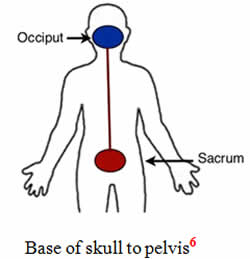
The main part of the diaphragm, a dome shaped muscle, separates chest and abdominal cavities; the fibres impact from the base of the skull to the pelvis and as a whole the diaphragm movement pumps cerebro-spinal fluid around the nervous system. This pumping is far less ‘beats per minute’ than the heart beat and can be distinguished from it with practice.
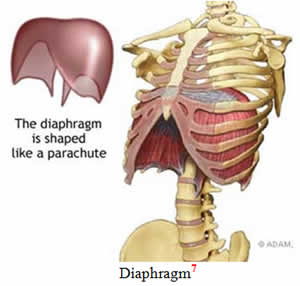
According to the late Professor Anthony Andreasen,[8] anxiety generates irritation which interferes with the smooth pumping of cerebro-spinal fluid and involves a stiff neck. He also attributes general energy depletion, heart failure and joint mobility to a dysfunctional diaphragm. This would concur with the aberrant breathing patterns and associated tachycardia in panic attacks and fits with the anatomical and physiological relationship between the heart and diaphragm. Professor Andreasen believes that the will to be well is generated via the centre of the diaphragm, the seat of the spark of life and first breath after birth. All of the electrical energy routes (meridians) pass through the diaphragm.
With a stiff neck the shoulder muscles can also become ‘like rope’ and this constricts the nerves and blood vessels which pass through the tight muscles as well as interfering with the meridians to the head and digestive system, causing problems especially for the stomach and ileo-caecal valve.
Tension in the diaphragm between chest and abdomen can cause a range of problems from milder digestive upsets like burps, bloating and wind, right through to extremely debilitating hiatus hernia, inflammatory gastritis and ileo-caecal valve (ICV) malfunction which can even mimic appendicitis and other conditions. This tension can also pull on intercostal muscles, resulting in spinal misalignment which will have a compensatory effect throughout the length of the spine and limbs. Chiropractic and kinesiology adjustments can be very helpful here in conjunction with correction of hiatus hernia[9] and ICV.[10] Cranio-sacral therapy[11] is another useful tool in balancing the cerebro-spinal fluid and releasing bodily tensions which work against normal diaphragm function. However, if the cause of the tension is not addressed then such treatments, useful as they are, are palliative.
Emotional stress, which seems somewhat common to us all, is associated with adrenaline / insulin imbalance, requires greater amounts of oxygen and water for cellular use and can be associated with vaso-constriction, raised blood pressure, tight neck muscles and headaches or migraines. This imbalance is greatly aggravated in an already dehydrated state where alcohol, coffee and heavy meals can substantially worsen dehydration. This would make sense of some of the known triggers of migraine attacks and the infamous angina and heart attacks after meals. Emotional stresses must be considered along with those factors which will be individually determined such as toxicity caused by toxic dental materials including mercury amalgam fillings, fluoride, root canal fillings etc., vaccinations, drug use (legal and illegal), adverse radiation, inappropriate and/or inadequate dietary intake, inadequate water and unrefined salt intake, detrimental life style choices, postural habits, childhood belief systems which cause adult anxiety states and behavioural problems, addictions and factors which could be revealed with thorough history taking.
There is a cause for every effect and therefore migraine will have a cause. However, because of the complexity of the age we live in it is unlikely to have a single cause but rather contributory, but nevertheless identifiable, causes which can be dealt with accordingly using the right ‘tools for the job’. As a brief example, if amalgam toxicity diminishes the uptake of fluids and nutrients to the cells, the first step would be replacement of such fillings (carried out properly by a dentist familiar with the importance of correct procedure) with non-fluoride white ones. This can be followed with homeopathic and/or herbal remedies to diminish mercury tissue load which would then enable more effective rehydration and nutritional uptake.
When the extent of diaphragm function is considered, it stands to reason that migraine could be one of many symptoms of diaphragm dysfunction rather than an unrelated and isolated painful inconvenience with no known cause. Popular recommended nutrients, herbs, homeopathics and dietary changes on their own, without considering the inter-relatedness of the triangle of ill health and the cause of migraine rather than the trigger, can be palliative at best.
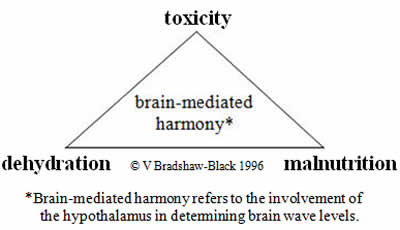
Triangle of ill health
Perhaps dealing with a core issue of diaphragm dysfunction along with correct breathing and a relaxed approach to challenges of life could render results for migraine sufferers. No one is without life’s challenges (a positive way of describing stressors and distresses) but approach to dealing with them is more productive in maintaining a state of health than either not having them or what they are.
Every emotional problem has a physical manifestation (whether seen or unseen) and every physical problem has an emotional aspect. Releasing emotional elements diminishes or even removes blocks to healing which do not arise from other factors such as toxicity from amalgam fillings or vaccinations. Emotions can impact diaphragm function on a very basic level right from birth (and even before).[13] Emotional stress release techniques, especially used in conjunction with kinesiology feedback and chiropractic work, can produce surprisingly quick and effective results and can be continued at home once you have the basics of stress release techniques.
Certain traumatic events which happened before memory recall or were blocked from conscious recall can still be dealt with through modalities such as emotional stress release and kinesiology. This does not refer to ‘re-living’ past events or traumas but rather to ‘defusing’ memory files of the past by disconnecting them from current events.
Meanwhile, alleviation of migraine symptoms can be helped with water and unrefined sea salt (can be added to warm/hot herb tea), quiet relaxation in a darkened room with a water bottle to the feet, and cool packs to the head and neck, herbal sedatives and relaxation, acupressure,[12] very gentle massage along the lower ridges of the skull bones and shoulder muscles, correction of the ileo-caecal valve and, for some people, extremely quiet relaxing music or nature sounds helps. Homeopathic remedies can be added to water or herb tea for heavy metal detoxification, known toxins, stress and pain relief along with herbal remedies for calming, digestion and inflammation.
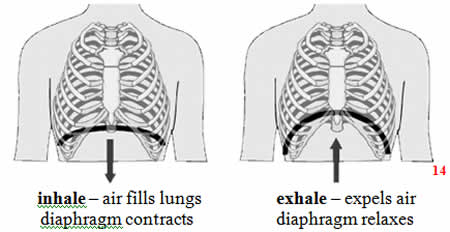
Sleep is a great relaxer and healer; all of the above can lead to sleepiness which will help the overall state of relaxation. Breathing should be gentle, without stress or effort, and the abdomen rising on the in-breath and lowered on the out-breath.
References
1. Image: http://askdrmakkar.com/migraine.htm
2. A cluster of warning symptoms which precede some migraines is called an aura which can include prickling sensations in the face, arms or legs, speech problems, dizziness, ‘feeling odd’ and mood changes. Migraines with an aura are called classical migraines and without an aura are called common migraines.
3. Image: http://www89.homepage.villanova.edu/angelo.milicia/Anatomy/Histology/Histology.htm
4. Image: http://www89.homepage.villanova.edu/angelo.milicia/Anatomy/Histology/Histology.htm
5. Unrefined sea salt is not to be confused with industrial grade processed sodium chloride sold as ‘ordinary salt’ or ‘table salt’. Unrefined sea salt is sun dried, unprocessed, without additives and nutritionally replete and when mixed with water is somewhat similar to plasma.
6. Image: http://yoginidoc.com
7. Image from: www.devonsmassage.com/breathing.php
8 The late Dr Anthony Andreasen (1906-1986), was born in Grimsby and trained as a doctor at Bart's where he qualified in 1930 and specialized in surgery in Edinburgh. He joined the military Indian Medical Service and worked in medicine in many places in Africa, South Africa and India. During the Second World War he was Colonel in Charge on the North West Frontier and afterwards held many prestigious consultancy and presidency offices to the highest levels in India until his departure to England in 1948. During his later medical career he worked in missionary hospitals and became a Fellow of the Royal Society, Edinburgh for his work on chest and open heart surgery. He also held multiple other prestigious titles and awards for his work in the USA and England amongst which he was a Cambridge University professor and consultant to the British School of Osteopathy. In his later years he developed his lifelong interest in complementary medicine and became a consultant in holistic medicine working from his home. He was fondly remembered by friends and colleagues as an outstanding human being ‘with a large caring heart’.
9, 10, 11, 12. There is an abundance of online demonstrations showing how to correct hiatus hernia, ICV malfunction, cranio-sacral and acupressure techniques as well as lists of your own local chiropractors, kinesiologists and cranio-sacral practitioners. Courses are also available for those who want to learn more and become practitioners in these areas.
13. A baby growing in the womb will have stressful reactions to the mothers stresses. For instance, nicotine from cigarettes will incite a biological stress reaction as well as to anger, toxicity and inadequacies (e.g. dehydration), all of which will cause anxiety of ‘unknown origins’ in the later child/adult. The brain works on a system of acceptance where ‘whatever’ is accepted until it is modified by something else. For instance, a child believes in something whether it is biologically or consciously/subconsciously decided and it will stay like that until something modifies or replaces that belief.
14. Image adapted from www.vocalpower.co.uk
Comments:
-
No Article Comments available